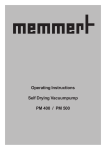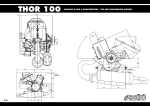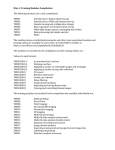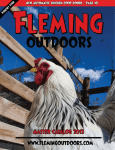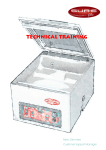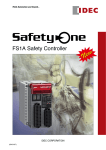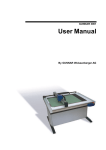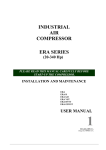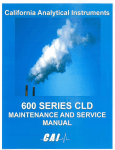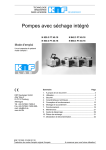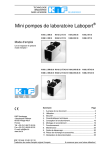Download Operating Instructions Self Drying Vacuumpump PM 200
Transcript
Operating Instructions Self Drying Vacuumpump PM 200 INNOVATIVE TECHNOLOGY WORLDWIDE Operating Instructions PM 16633-842.3 Self Drying Pumps Laboratory Vacuum Pumps with Drying System PM 16633-842.3 You have selected a high-quality KNF product; the following tips will help you operate it safely, and reliably over a long period of time. Carefully study operating instructions before using the pumps and observe at all times the relevant instructions to avoid dangerous situations. 0. List of Contents 1. Description, Operating Conditions 2. Safety 3. Installation 4. Operation 5. Servicing 6. Trouble Shooting 7. Ordering Information 8. Specifications KNF resrve the right to make changes 1. Description, Operating Conditions The pumps transfer, and evacuate 100 % oil-free. In operation they are gastight, and maintenance-free. The self drying pumps make it possible during evacuation to blow the condensed liquid out of the pump heads at high speed, while maintaining the vacuum in the recipient at a constant level. After drying the pump heads the pumps achieve a greatly improved vacuum and evacuate much faster than pumps without a drying system. Warning When the pumps are operating the following ambient conditions must be maintained: The interval between pump head ventilation operations (t3). 2. Safety This pump model is equipped with the solenoid valve for ventilating the pump heads. The scope of delivery does not include control electronics. 1.1 Electrical Equipment See section 8 for full electrical data. The pumps are fitted with a thermal -switch to protect against overloading. 1.2 Operating Conditions The pumps and/or the drying system must not be used in areas where there is a danger of explosion. These pumps must not be used if the entry of air into the pump during venting (drying system) could result in the creation of reactive, explosive or otherwise hazardous mixtures. Prior to any use of the pump ensure that the creation of reactive, explosive or otherwise hazardous mixtures during the supply of air is prevented. For maximum permissible operating pressure, ultimate vacuum, and flow capacity: see chapter 8. sign below are only allowed to be opened after pulling out the plug (disconnecting the power source). Use only original KNF replacement parts. 1.3 Ambient Condition The duration of the ventilation of the pump heads (t2) The time between switching on the drying system and the first ventilation of the pump heads (t1) = Position in the illustration, = Important point, = Task, = Advise to users, If your potential application lies outside the above limits discuss it with our technical adviser (see last page for contact telephon number). The pumps and/or the drying system must not be used in areas where there is a danger of explosion. Ambient temperature during operation: between + 5 °C .... + 40 °C. During operation an adequate supply of air for cooling must be provided. The control for the drying system is effected via soleonid valve and three variables: PM 1633-842.3-3.00 e 11/05 Symbols: The pumps must not be used for liquids. You will find suitable liquid pumps in our Product Program. Note that the pumps may only be used for their intended purpose. The pumps and/or the drying system must not be used in areas where there is a danger of explosion. These pumps must not be used if the entry of air into the pump during venting (drying system) could result in the creation of reactive, explosive or otherwise hazardous mixtures. Prior to any use of the pump ensure that the creation of reactive, explosive or otherwise hazardous mixtures during the supply of air is prevented. Components connected to the pumps must be designed to withstand the pneumatic performance of the pumps (see chapter 8). Plug the pump only into properly installed grounded outlets. When the operation of the pump is interrupted by the thermal switch, it will re-start automatically after cooling down. Take all care necessary to prevent this leading to a dangerous situation. Specific safety instructions and measures for the media being handled must be observed. Parts of the casing marked with the 2 3. Installation Choose a safe location (flat surface for the pump). Install the pump so as to ensure adequate flow of air cooling. Connect the suction and pressure lines (tube ID 10 mm). Arrange the pressure line so that condensate can flow out of the the pump (falling pipe). The condensate is conducted out of the pump via the pressure line. A container is to be installed to catch the condensate. The solenoid valve must be connected to the drying system control electronics (not included in scope of delivery); see fig. 1. Plug the pump only into properly installed grounded outlets. Compare the supply data with the elecetrical data of the pump. The voltage must not vary by more than + 10 %, and -10 % from that shown on the type-plate. 4. Operating Instructions 4.1 Operating Conditions The pumps and/or the drying system must not be used in areas where there is a danger of explosion. These pumps must not be used if the entry of air into the pump during venting (drying system) could result in the creation of reactive, explosive or otherwise hazardous mixtures. Prior to any use of the pump ensure that the creation of reactive, explosive or otherwise hazardous mixtures during the supply of air is prevented. Specific safety instructions for the media being handled must be observed. Valve voltage 24 V DC blue (-) for tube ID 10 brown (+) 231 Mains switch Fig. 1: Pump PM 16633-842.3-3.00 The pumps must not start against pressure. This also applies when the pump restarts after the power has been cut off for a short period. The components to be connected to the pump must be designed to withstand the pneumatic data of the pumps (see Section 8). The maximum permissible operating pressure (1 bar g) must not be exceeded. To prevent the maximum permissible operating pressure being exceeded, restriction or control of the air or gas flow should only be carried out in the suction line. If restriction or control of the air or gas flow is made on the pressure side ensure that the maximum permissible operating pressure is not exceeded. When the pump is at a standstill the inlet and the outlet must be at normal atmospheric pressure. PM 1633-842.3-3.00 e 11/05 Ensure the pump outlet is not closed or restricted. Diaphragm and valve plates are the only parts subject to wear. Wear is usually indicated by a drastic reduction in the pneumatic performance. When replacing parts proceed as described in section 5. Ambient conditions: see chapter 1.3. 4.2 Operation Taking the pump into operation Plug the mains plug of the pump into a properly installed safety socket. Switch the pump on at the pump mains switch (see fig. 1). If cyclic drying of the pump heads is required in the current evacuation process, switch the drying system on at the mains switch of the control (not included in scope of delivery). The drying system should only be switched on if a container has been attached to the pressure line of the pump which will catch the condensate; otherwise the condensate will flow out uncontrolled. Check: Tubing for correct tubing. Electrical connections for correct connection. After the evacuation/process has been completed, take the pump out of operation: Purge the pump including the connecting hoses with air at full 3 flow rate for about 5 minutes. If the drying system is switched on: Switch the drying system off at the mains switch of control system (not included in scope of delivery). Switch the pump off at the mains switch of the pump. Pull the mains plug of the pump out of the socket. 5. Servicing: Changing Diaphragms and Valve Plates/Sealings The structured diaphragms in both pump heads should be changed at the same time. When diaphragms are changed, valve plates/sealings should also be replaced. If the diaphragms are not changed in both heads at the same time or diaphragms and valve plates/ sealings are not changed at the same time the nominal performance of the pump is not guaranteed after the service. If a pump has been used for aggressive or toxic substances or other types of substances which are hazardous, hazardous to health, or injurious, the following points must be observed: 1.) Clean the pump and its compo- Orientation of disk springs Pump N 842_ has a round shape of head Specification Screw (12x) Screw (3x) Disk spring Top plate Head plate Valve plate/sealing Intermediate plate Guide pin Structured diaphragm Spacer (thick) Spacer (thin) Dampening ring A Screw Dampening felt Dampening ring B Adapter Dampening ring C Dampening diaphragm PM 1633-842.3-3.00 e 11/05 Required tools and material: Service Set (see section 7) Philips-head screwdriver No. 2. Change the structured diaphragms and valve plates/sealings in the following sequence: a.) b.) c.) d.) e.) f.) c.) Change structured diaphragms Push down one structured diaphragm until other diaphragm is pushed upwards to its highest position. Carefully unscrew the higher strucutred diaphragm anti-clock wise using both hands. Replace all spacers / onto the screw thread of the new structured diaphragm (same number and order) Screw in the new structured diaphragm and tighten it by hand; you do not need any tool. Change the second structured diaphragm as described above (step to ) for the first. Changing the two diaphragms one after the other ensures that the same number of diaphragm spacers are refitted as were removed. This is essential to maintain the pneumatic performance of the pump. Fig. 2: Pump head for N 842.3_ (exploded drawing, symbolic) nents before servicing. 2.) Ensure that the service personnel is not subject to a health hazard. Apply the safety and protection measures that are necessary for the medium that has been handled by the pump (example: the use of protective gloves). 3.) Ensure that discarded parts and materials are safely and correctly disposed of. Use only original KNF replacement parts. On the pneumatic head connections, loosen one of the union nuts by hand. Then slightly loosen the angle-fitting in the pump head by turning it anticlockwise, so that the connecting tube can be pulled out. Loosen the outer screws on each pump head. Carefully remove both pump heads (top plate , head plate and intermediate plate ). The soleonid valve of the drying system remains fitted in this situation. Preparatory steps Remove pump heads Change structured diaphragms Change valve plates/sealings Refit pump heads Final steps. d.) Change valve plates/sealings Unscrew the three screws in the top plate of one pump head. Carefully remove top plate and head plate from intermediate plate ; exposing the valve plates/sealings . The postion numbers in the following text refer to fig. 2. Remove old valve plates/sealings . a.) Preparatory Steps Shut down system (see section 4.2) If there should be deposits in the recesses in the intermediate plate , clean them until the deposits have been completly removed. including disconnecting the pump from the power source (pull out plug of electrical supply unit). Remove tubing from the inlet and outlet connectors of the pump. b.) Removing the pump heads 4 Insert new valve plates/sealings in the recesses in the intermediate plate (upper and lower sides of the valve plates/sealings are identical). Carry out the steps to for the second pump head. 6. e.) Refitting the pump heads At one pump head: Press the lip on the edge of the structured diaphragm into the groove in the housing. Place the intermediate plate , with the valve plates/sealings on the adapter . Place the head plate on the intermediate plate in the position indicated by the guide pin . Place the top plate on the head plate in the right position. Gently tighten screws in diagonal order. Screw in the three screws in the centre of the pump top plate until they are flush with the top plate; then screw one final half turn to tighten. For orientation of disk springs see fig. 2. Carry out steps to for the second pump head. ! Refit the pneumatic head connection: Place tube onto the connecting part of the angle fitting, turn angle fitting to a straight position and tighten the union nut. f.) Final steps Reconnect system tubing. Reconnect the pump to the electricity supply. PM 1633-842.3-3.00 e 11/05 If the pump does not reach the desired vacuum after changing diaphragms and valve plates/sealings: Check whether the spacers have been replaced onto the diaphragm screw thread. Check the interconnecting pipework connection between both pump heads as well as the tubing for leaks. Possibly the screws on one of the pump heads (or both heads) are insufficiently tightened (carefully tighten them again crosswise). Troubleshooting Sufficient vacuum is not reached Order No. 057359 Possible reasons: Tube connections are not tight Condensate in the pump head Switch the drying system on or reduce the interval between pump head ventilation operations. Diaphragms and/or valve plates/ sealings are worn out Changing diaphragms and valve plates/sealings: see section 5. If this problem occurs after changing of diaphragms or valve plates/sealings: See information in section 5. Pump is switched on, but does not run, the on/off-switch on the pump is not lit Possible reasons: Pump is not connected with the power source. No voltage in the power source. Fuse in the pump is defective (only authorized/qualified personnel should investigate this problem): Disconnect the pump from the power source by pulling out plug. 8. Permissible ambient temperature: +5... +40°C Hose connection for tube ID 10 mm Voltage pump: 230 V Frequency: 50 Hz Power consumption pump: 220 W Fuse pump (2 x): 3.15 T [A] IP 44 Voltage soleonid valve 24 V DC CE - Safety Demands The pumps correspond to the safety regulations of the EU low voltage directive 73/23 EWG and of the EU directive concerning electromagnetical compatibility 89/336 EWG. The requirements of the following harmonised standards are fulfilled: EN 55014 EN 61000-6-1 EN 61000-6-3 EN 61000-3-2/3 EN 61010-1 The pumps correspond to IEC 664: Dimension of the fuse: see section 8. Pump is switched on, but does not run, the on/off-switch on the pump is lit Possible reason: The thermal switch has opened due to overheating Disconnect the pump from the power source, let the pump cool down, investigate the reason for the overheating and irradicate it. Service Set A Service Set contains all replacement parts needed for one complete service of the pump. 5 Specifications Capacity: max. 34 l/min Ultimate vacuum: 4 mbar abs Permissible operating pressure: max. 1 barg Placement of fuse: The fuse is accessible after opening the marked cover at the bottom of the pump. 7. Ordering Information If you have any questions about servicing call our technical adviser (see last page for contact telephone number). Service Set contains 2 diaphragms and 4 valve plates/ sealings the overvoltage category II the pollution degree 2. Appendix: Customer statement for repair order (sample statement for copying) In order for KNF to repair the pump, the customer must provide a statement on the media which were pumped and on pump cleaning. Please fill out the corresponding KNF form, and submit it together with the pump. Statement/Certificate We confirm that the pump model listed below (please specify) ............................................. ............................................. ............................................. Serial-No. (please specify) ............................................. ............................................. ............................................. was used to pump the following media: ............................................. ............................................. ............................................. ............................................. ............................................. ............................................. ............................................. and that the pump listed above was cleaned. There are no poisonous, aggressive, biological, radioactive or other dangerous media in the pump. PM 1633-842.3-3.00 e 11/54 ................ Company ...................... Date/ Signature KNF Neuberger GmbH Alter Weg 3 D-79112 Freiburg Tel. ++49/7664/5909-0 Fax ++49/7664/5909-99 E-Mail: [email protected] www.knf.de english 25.11.2005 D 08851









